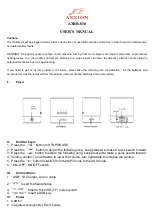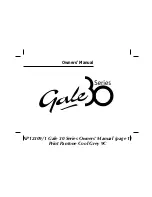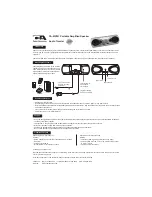
LRAD
1950XL
GENASYS INC.
Manual Part No.:114931-00 rev. B
13
•
When choosing a placement area to maximize unobstructed transmission path(s), care must
be taken to ensure the LRAD
1950XL does not collide with any structures or equipment, nor
encroach on personnel passageways when the unit is pivoted and manipulated through its
full range of motion.
The LRAD
1950XL
’s MP3
Control Unit and Microphone can be placed away from the Head Unit
for operation by a second person. The system ships with a standard control unit cable. For
pricing and delivery information on alternate cable lengths, please contact your Genasys sales
representative.
5.2 Aiming
The LRAD
1950XL can be accurately aimed at the vehicle or personnel the operator is
attempting to communicate with using one of the four attached visual sighting devices. The
sights are located on the left and right sides of the LRAD
1950XL. The operator simply looks
through the hole on the sight and aligns the target in the cross hairs.
NOTE: The LRAD
1950XL audio transmission is very directional. It may be necessary to make
aiming corrections for strong crosswinds when communicating over long distances.
5.3 Environmental Conditions Affecting Aiming
At distances of 1000 meters or more, some environmental conditions will begin to have an
impact on the clarity and volume of sound delivered to a target. These are some of the factors
that will affect the LRAD’s abil
ity to project clear audio to distances beyond 1000 meters.
•
Temperature Gradients
–
Temperature gradients can behave like lenses to the acoustic
output of the LRAD, causing the acoustic beam to deflect and weaken. Temperature
gradients can be caused by varying terrain surfaces like blacktop, grass, water and by
conditions such as shade and wind. Improved ranges can be achieved when
broadcasting over a surface that has a consistent temperature, such as water, as
opposed to broadcasting over terrain that may have large temperature variations, such
as a blacktop road being heated by the sun.
•
Moisture and Humidity
–
Moisture and humidity in the air, such as fog or light rain, will
have a very small effect on the range of the LRAD. Also, moisture does tend to aggravate
the effects of wind on the range of the LRAD.
•
Winds
–
H
igh winds may cause the LRAD’s sound beam to shift, making it difficult to aim
at long distances. Noting that the sound from the LRAD will take around 3 seconds to
reach a target at 1000 meters, the user should attempt to compensate for this as well as
for any effects of cross winds.
•
Noise Levels at the Target’s Position
–
High winds, engine noise, and other background
noises will have to be overcome by the LRAD in order for the target to clearly hear and
understand the LRAD. Targets that are indoors or protected by a barrier will not be able
to hear the LRAD as clearly as those who are out in the environment.














































